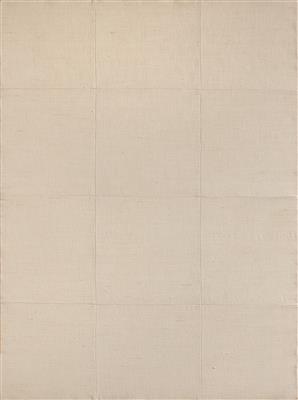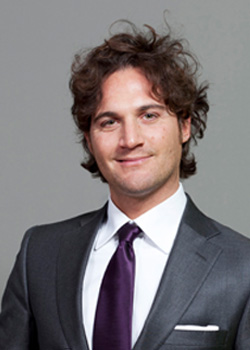Piero Manzoni *

(Soncino 1933–1963 Milan)
Achrome, 1959/1960, inscribed on the reverse, canvas sewn in squares, 71 x 53 cm, framed
Provenance:
Galleria Notizie, Turin (stamp on the reverse)
Galerie Thelen, Essen
Galerie Ronny Van de Velde, Antwerp
Lenz Schönberg Collection, Salzburg (acquired in 1987)
Sotheby’s London, 10 February 2010, lot 23
European Private Collection
Exhibited:
Antwerp, Galerie Ronny Van de Velde, Piero Manzoni, 1987
Munich, Städtische Galerie im Lenbachhaus, ZERO. Vision und Bewegung. Werke aus der Sammlung Lenz Schönberg, 1988,
exh. cat. p. 65 with ill.
Moscow, Zentrales Künstlerhaus, Sammlung Lenz Schönberg.
Eine europäische Bewegung in der bildenden Kunst von 1958 bis heute, 1989
Warsaw, Galeria Zacheta, Sammlung Lenz Schönberg. Aus der Stille der Zeit-über die Grenzen von Raum, 28 February -
5 April 1992, exh. cat. p. 133 with ill. (label on the reverse)
Zagreb, Museum für zeitgenössische Kunst, ZERO. Die europäische Vision-1958 bis heute. Sammlung Lenz Schönberg, 2004, exh. cat. p. 91 with ill.
Salzburg, Museum der Moderne. ZERO. Künstler einer europäischen Bewegung. Sammlung Lenz Schönberg 1956–2006
Literature:
F. Battino, L. Palazzoli, P. Manzoni, Piero Manzoni Catalogue raisonné, Edizioni di Vanni Scheiwiller, Milan 1991, p. 353,
no. 646 with ill.
G. Celant, Piero Manzoni, Catalogo Generale, Skira, Milan 2004, Vol II, p. 489, no. 631 with ill.
A. Lenz, G. Lenz and U. Bleicker-Honisch, Epoche zero. Sammlung Lenz Schönberg. Leben in Kunst, vol. I, Ostfildern 2009, p. 55,
no. MAN-11 with ill.
Presenting his Achrome series in January 1960 in “La nuova concezione artistica” at the Azimut gallery in Milan, Manzoni writes: “The question for me is to render an entirely white surface (or rather an entirely colourless, neutral surface) outside of any pictorial phenomenon, of any intervention extraneous to the surface value; a white surface that is not a polar landscape, an evocative or beautiful material, a sensation or a symbol or something else; a white surface that is just a white surface (a colourless surface that is a colourless surface) or, better yet, that just is, pure and simple (and total being is pure becoming).”
The Achrome, literally “acromatic surface”, is an open space with infinite possible meanings; initially a white surface of chalk or kaolin, the Achrome is not arranged according to an artistic compositional principle in the classical sense and does not exhibit manipulation of the material; the transformation of the material is entrusted to an autonomous and self-sufficient process by the artist, who limits himself to immersing the canvas in liquid kaolin and glue.
Unlike in Fontana’s or Pollock’s works, where the artist’s gesture is part of the creative process, in the Achrome Manzoni’s creative power is voluntarily held back, blocked. The artist lets the image manifest itself as pure expression.
Manzoni’s approach to the Achrome changed over the years, testifying to a change in the artist’s conception of art and matter: white became an increasingly mental fact and less and less linked to the pictorial code, while the question of the body, making its way through other artistic practices, took the form of the adoption of materials traditionally foreign to the discipline of art, from cotton wool to cloth, from expanded polystyrene to pebbles.
On the pictorial surface of the Achrome, the material thickens with a sculptural effect, unfolding in reliefs that “do not respond to any formative reason, enunciating its substantial objecthood but without involving components of visibility as is the case for almost all contemporary research, in Europe as well as in the United States.”
For Manzoni, the fold, which geometrically divides the surface of the work, becomes a sign, a presence, which is not intended to validate the gesture or the creative process of the artist, but rather becomes presence, a tactile presence, physically determined but infinite. Thus also the choice of the geometric sign in the form of the grid, which is not placed in continuity with previous metaphysical research, but nonetheless recalls the idea of the work of art as essence and materiality.
“In the varyingly creased Achromes – as well as in those with minimal materiality, in which subdivision was achieved by overlapping portions of the canvas, or directly intervening with neat machine-made stitching — Manzoni focuses on a kind of ‘materiology.’ This relates to what Michael Fried would refer to as ‘the minimal conditions for something’s being seen as a painting’ — the configuration of a presence that is objectified as a thing among things, but which visibly claims its otherness. […]
The general form of the Achrome corresponds, in the eyes of the viewer, to the rhetorical pattern of the painting, but its substance is pure; it has an unqualified physical presence, reduced to its primary, indiferent essence. The work can thus be an object in itself and, at the same time, an abstract manifestation of thought.”
Piero Manzoni: The Idea of the Achrome, in Piero Manzoni. The Twin Paintings, Hauser & Wirth Publications - Fondazione Piero Manzoni, Zurich 2017
A single uninterrupted and continuous surface from which anything superfluous and all interpretative possibilities are excluded. [referring to his ‚Achromes‘]
Piero Manzoni
Expert: Alessandro Rizzi
 Alessandro Rizzi
Alessandro Rizzi
+39-02-303 52 41
alessandro.rizzi@dorotheum.it
27.11.2019 - 18:00
- Dosažená cena: **
-
EUR 735.300,-
- Odhadní cena:
-
EUR 400.000,- do EUR 600.000,-
Piero Manzoni *
(Soncino 1933–1963 Milan)
Achrome, 1959/1960, inscribed on the reverse, canvas sewn in squares, 71 x 53 cm, framed
Provenance:
Galleria Notizie, Turin (stamp on the reverse)
Galerie Thelen, Essen
Galerie Ronny Van de Velde, Antwerp
Lenz Schönberg Collection, Salzburg (acquired in 1987)
Sotheby’s London, 10 February 2010, lot 23
European Private Collection
Exhibited:
Antwerp, Galerie Ronny Van de Velde, Piero Manzoni, 1987
Munich, Städtische Galerie im Lenbachhaus, ZERO. Vision und Bewegung. Werke aus der Sammlung Lenz Schönberg, 1988,
exh. cat. p. 65 with ill.
Moscow, Zentrales Künstlerhaus, Sammlung Lenz Schönberg.
Eine europäische Bewegung in der bildenden Kunst von 1958 bis heute, 1989
Warsaw, Galeria Zacheta, Sammlung Lenz Schönberg. Aus der Stille der Zeit-über die Grenzen von Raum, 28 February -
5 April 1992, exh. cat. p. 133 with ill. (label on the reverse)
Zagreb, Museum für zeitgenössische Kunst, ZERO. Die europäische Vision-1958 bis heute. Sammlung Lenz Schönberg, 2004, exh. cat. p. 91 with ill.
Salzburg, Museum der Moderne. ZERO. Künstler einer europäischen Bewegung. Sammlung Lenz Schönberg 1956–2006
Literature:
F. Battino, L. Palazzoli, P. Manzoni, Piero Manzoni Catalogue raisonné, Edizioni di Vanni Scheiwiller, Milan 1991, p. 353,
no. 646 with ill.
G. Celant, Piero Manzoni, Catalogo Generale, Skira, Milan 2004, Vol II, p. 489, no. 631 with ill.
A. Lenz, G. Lenz and U. Bleicker-Honisch, Epoche zero. Sammlung Lenz Schönberg. Leben in Kunst, vol. I, Ostfildern 2009, p. 55,
no. MAN-11 with ill.
Presenting his Achrome series in January 1960 in “La nuova concezione artistica” at the Azimut gallery in Milan, Manzoni writes: “The question for me is to render an entirely white surface (or rather an entirely colourless, neutral surface) outside of any pictorial phenomenon, of any intervention extraneous to the surface value; a white surface that is not a polar landscape, an evocative or beautiful material, a sensation or a symbol or something else; a white surface that is just a white surface (a colourless surface that is a colourless surface) or, better yet, that just is, pure and simple (and total being is pure becoming).”
The Achrome, literally “acromatic surface”, is an open space with infinite possible meanings; initially a white surface of chalk or kaolin, the Achrome is not arranged according to an artistic compositional principle in the classical sense and does not exhibit manipulation of the material; the transformation of the material is entrusted to an autonomous and self-sufficient process by the artist, who limits himself to immersing the canvas in liquid kaolin and glue.
Unlike in Fontana’s or Pollock’s works, where the artist’s gesture is part of the creative process, in the Achrome Manzoni’s creative power is voluntarily held back, blocked. The artist lets the image manifest itself as pure expression.
Manzoni’s approach to the Achrome changed over the years, testifying to a change in the artist’s conception of art and matter: white became an increasingly mental fact and less and less linked to the pictorial code, while the question of the body, making its way through other artistic practices, took the form of the adoption of materials traditionally foreign to the discipline of art, from cotton wool to cloth, from expanded polystyrene to pebbles.
On the pictorial surface of the Achrome, the material thickens with a sculptural effect, unfolding in reliefs that “do not respond to any formative reason, enunciating its substantial objecthood but without involving components of visibility as is the case for almost all contemporary research, in Europe as well as in the United States.”
For Manzoni, the fold, which geometrically divides the surface of the work, becomes a sign, a presence, which is not intended to validate the gesture or the creative process of the artist, but rather becomes presence, a tactile presence, physically determined but infinite. Thus also the choice of the geometric sign in the form of the grid, which is not placed in continuity with previous metaphysical research, but nonetheless recalls the idea of the work of art as essence and materiality.
“In the varyingly creased Achromes – as well as in those with minimal materiality, in which subdivision was achieved by overlapping portions of the canvas, or directly intervening with neat machine-made stitching — Manzoni focuses on a kind of ‘materiology.’ This relates to what Michael Fried would refer to as ‘the minimal conditions for something’s being seen as a painting’ — the configuration of a presence that is objectified as a thing among things, but which visibly claims its otherness. […]
The general form of the Achrome corresponds, in the eyes of the viewer, to the rhetorical pattern of the painting, but its substance is pure; it has an unqualified physical presence, reduced to its primary, indiferent essence. The work can thus be an object in itself and, at the same time, an abstract manifestation of thought.”
Piero Manzoni: The Idea of the Achrome, in Piero Manzoni. The Twin Paintings, Hauser & Wirth Publications - Fondazione Piero Manzoni, Zurich 2017
A single uninterrupted and continuous surface from which anything superfluous and all interpretative possibilities are excluded. [referring to his ‚Achromes‘]
Piero Manzoni
Expert: Alessandro Rizzi
 Alessandro Rizzi
Alessandro Rizzi
+39-02-303 52 41
alessandro.rizzi@dorotheum.it
|
Horká linka kupujících
Po-Pá: 10.00 - 17.00
kundendienst@dorotheum.at +43 1 515 60 200 |
| Aukce: | Současné umění I |
| Typ aukce: | Salónní aukce |
| Datum: | 27.11.2019 - 18:00 |
| Místo konání aukce: | Wien | Palais Dorotheum |
| Prohlídka: | 16.11. - 27.11.2019 |
** Kupní cena vč. poplatku kupujícího a DPH
Není již možné podávat příkazy ke koupi přes internet. Aukce se právě připravuje resp. byla již uskutečněna.
Všechny objekty umělce
